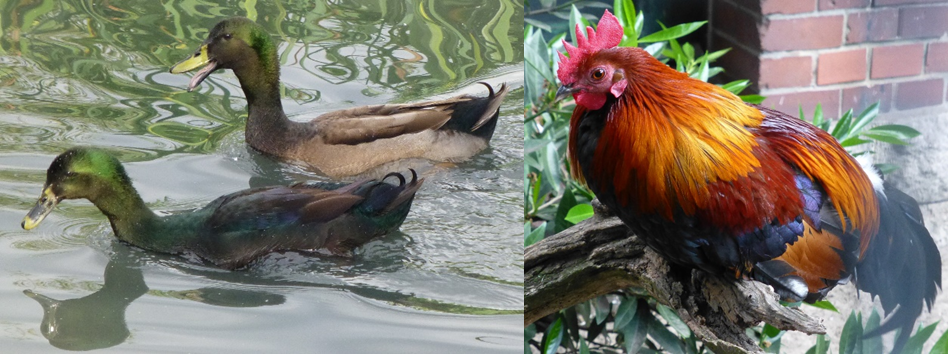



Ancestral wisdom: natural behaviours
Relating your birds’ daily habits and practices to their evolutionary past can reveal their natural patterns of behaviour – and provide important lessons for keeping them healthy and happy.Part of Series:
Next Article in Series >
Back-garden chicken and duck keeping is becoming increasingly popular in the UK, with recent estimates suggesting 600,000 plus people have hens as pets at home (making them more popular than some traditional furry friends like hamsters and guinea pigs). Keeping chickens and other poultry happy and healthy at home can be relatively easy; the familiarity of birds to their owners means problems can be quickly spotted and rectified.
Good housing and husbandry are key: providing the right resources (food, shelter, environmental enrichment, social grouping) safeguards good health by reducing stress. To be sure that these resources are properly in place and that your birds are stress free, an understanding of the ancestry of these domesticated birds is indispensable. It means you’ll be assured that your birds are being given environments that allow them to perform important behaviours that lead to good physical and psychological health.
In this first of two articles, the natural behaviour patterns of these animals will be explored and, ultimately, by learning more about their wild ancestry, how to ensure they experience a good quality of life.
Individuals in populations matter. How we understand their behaviour tells us about their health and wellbeing – and, therefore, how they are likely to influence the behaviour, health or wellbeing of the animals around them. In large flocks of commercial poultry, it may be very difficult to determine individual behaviour patterns, but on a smaller scale, keepers will know their animals as individuals. Sudden changes to apparent “normal” personality characteristics or demeanours will be indicative of something not being quite right with a particular bird. Experienced keepers will know that birds can be very good at hiding indications of ill health and will may only show signs of disease when they are gravely ill. Daily checks on the external condition of birds will give a good “heads up” of how an individual is faring and comparing day-on-day records means individual benchmarks can be used for judging health.

Activity, demeanour, expression and body condition all give a good idea of a bird’s internal and external health as well as a way of understanding its current state of well-being. Providing opportunities for beneficial activities, such as a digging and scratching, improve physical and psychological health. © Brent Huffman
There are signals of ill health that both small- and large-scale poultry keepers can become familiar with and soon identify. Such key indicators of sickness include: a change in stance; a decrease in the amount of time spent on preening and maintenance behaviours; spending more time withdrawn or seeming apathetic; and becoming socially isolated. Loss of body condition might only be apparent on direct handling, but changes to the colour and integrity of bare areas, such as combs, wattles and skin around eyes, can be useful first indicators that something is wrong. The presence of soiled, unkept feathers, especially around the bird’s vent, is also an obvious sign that a bird is not in peak fitness.
In waterfowl, damp, unkempt and dirty feathers will cause a bird to spend less time swimming or entering water. This is a conundrum in itself, as such a feather problem can often be rectified by the provision of clean water, deep enough for a bird to bathe in. Poor plumage condition and bare patches in chickens can require a deeper examination as these symptoms can be suggestive of a nutritional deficiency, a parasite infestation or a loss of social position and bullying from another bird in the flock.
What is common to many of these ailments is their preventable nature if the bird’s behavioural needs are fully considered during husbandry and management. For example: a stable social group and the correct ratio of males to females can reduce the chances of bullying and aggression between birds. Providing plentiful opportunities for dust bathing can reduce feather parasites. Multiple areas to feed in (several clean stations providing a complete pelleted food) allows all birds to meet energetic and nutritional demands. Water – if not deep enough to swim in, at least deep enough for a duck to immerse its head completely to scoop water over its body – ensures feather cleaning and subsequent oiling of plumage.

Providing the right stimuli for these behaviours gives an outlet for important behavioural needs that underpin excellent physical and psychological health, and hence prevent veterinary interventions to rectify illnesses caused by management conditions © Paul Rose
Measurement of behavioural demand may be a useful way of assessing the welfare needs of chickens and ducks housed in small- and large-scale set-ups. “Behavioural demand” is a term that explains how much effort an animal will put in to obtain a commodity that it deems attractive. It’s already well known that ducks have a desire for whole-body water access (and the need for this to be provided more regularly in commercial farming is beautifully explained in Treena Hein’s article from January 2019). Providing information on the value of this resource can give more weight to enforcing a policy of full-body water access for ducks on commercial farms.
Recent research published in the journal Applied Animal Behaviour Science demonstrates the capabilities of domestic ducks to learn a new behaviour, the performance of which can indicate the value in aspects of the bird’s environment. In this instance, scientists trained individual Pekin ducks to push a door to open it and gain access back to their flock. The more weight on the door, the harder the bird had to work return to its flock. As ducks were prepared to push a weight equivalent to 100 percent of the average bodyweight of the group to gain access to their flock, this showed that social contact is an important resource upon which a duck places significant value.
Such experiments provide insight into the behavioural needs of the animals that we keep; data gathered from them can be used to inform practice. For example, housing birds in natural social groups or reducing the amount of time an individual spends alone due to husbandry or management actions can be determined based on empirical study.
Why does behaviour matter so much? Because it’s the way an animal expends energy and fulfils a psychological and physiological need. Behaviour is the observable response to stimuli, and therefore correct behaviour patterns show that animals are responding to appropriate environmental conditions. In the next article, how the wild ancestors of modern chickens and ducks help us to get these conditions right will be explored, with a view to ensuring birds have an outlet for welfare-positive behaviours.
| References | ||||
|---|---|---|---|---|
| Barrett, L.A., and Blache, D. | ||||
| (2019) | Development of a behavioural demand method for use with Pekin ducks | |||
| Roberts, V. and Scott-Park, F | ||||
| (2008) | BSAVA manual of farm pets | |||
| Stamp Dawkins, M. | ||||
| (2014) | Using behaviour to assess animal welfare |










